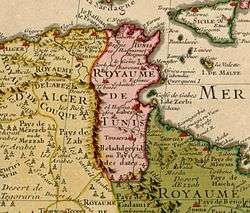Beylik of Tunis
The Beylik of Tunis was a largely autonomous beylik of the Ottoman Empire founded on July 15, 1705, after the Husainid Dynasty led by Al-Husayn I ibn Ali at-Turki defeated the Turkish Deys, that controlled what is now Tunisia.
Beylik of Tunis | |||||||||
|---|---|---|---|---|---|---|---|---|---|
| 1705–1881 | |||||||||
Anthem: "Salam al-Bey" | |||||||||
 The Beylik of Tunis in 1707 | |||||||||
| Status | Beylik of the Ottoman Empire | ||||||||
| Capital | Tunis | ||||||||
| Common languages | Tunisian Arabic, Ottoman Turkish, Judeo-Tunisian Arabic, Berber | ||||||||
| Religion | Sunni Islam and Judaism | ||||||||
| Government | Monarchy | ||||||||
| Bey | |||||||||
• 1705–35 | Al-Husayn I ibn Ali at-Turki | ||||||||
• 1859–81 | Muhammad III as-Sadiq | ||||||||
| History | |||||||||
• Established | 15 July 1705 | ||||||||
• Protectorate | 12 May 1881 | ||||||||
| Currency | Tunisian rial (to 1891) Tunisian franc (1891 on) | ||||||||
| |||||||||
| Today part of | |||||||||
Part of a series on the |
||||||||||||||
|---|---|---|---|---|---|---|---|---|---|---|---|---|---|---|
| History of Tunisia | ||||||||||||||
 | ||||||||||||||
|
Prehistoric |
||||||||||||||
|
Ancient
|
||||||||||||||
|
|
||||||||||||||
|
||||||||||||||
|
| ||||||||||||||
Ottoman beylik
Although defeating the Deys, Tunisia continued to be a vassal of the Ottoman Empire and the Friday prayer was pronounced in the name of the Ottoman Sultan, money was coined in his name, and an annual ambassador brought gifts to Constantinople, but the Ottomans never again exacted obedience.
In the 19th century, the country became mostly autonomous, although it was still officially an Ottoman province. In 1861, Tunisia enacted the first constitution in the Arab world, but a move toward independence was hampered by the poor economy and political unrest. In 1869, Tunisia declared itself bankrupt, and an international financial commission with representatives from France, United Kingdom, and Italy took control over the economy.
French protectorate
Tunisia became a protectorate of France on May 12, 1881, after the French claimed that Tunisian troops had crossed the border into their colony of Algeria. Tunisia later received its independence from France on March 20, 1956.
See also
- Beg (title), Baig
- History of Tunisia
- List of Beys of Tunis
- Ottoman Tunisia
References
External links

.svg.png)
